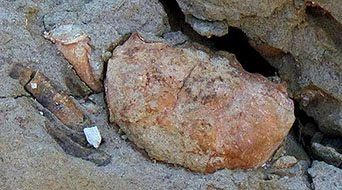If a collector is fortunate, some localities yield a few fossil crabs. This post is about a species of crab, Orbitoplax weaveri (Rathbun, 1926) which can be found in Eocene (approximately 50 million year old) rocks on the west coast of the United States, from southwestern Washington to southern California.
Orbitoplax weaveri is the updated genus name of this crab. It has been erroneously placed in other genera, thus in the older literature this species was called Plagiolophus weaveri and then Glyphithyreus weaveri.
The main part (carapace) of this recently collected specimen is 22 mm (nearly an inch) wide. There are also parts of three of its legs on the left side of the specimen. The collector who found and photographed the specimen kindly gave it to me.
This is another picture of the carapace of the same specimen, after it was removed from the rock. This picture was taken under low-angle lighting to show the sculptural details.
This is another and larger (main part 25 mm) specimen of O. weaveri, which I collected many years ago from the same locality as the one shown above. Its right pincher is intact. Also, a impression of the claw part of the left pincher is present. The total width (from left to right) of the specimen is 55 mm.
Complete or nearly complete crabs like the ones shown above are typically found in silty sands, which were deposited under relatively quiet-water conditions. Just down section a few meters, there are storm beds with numerous Turritella gastropods, whose shells display preferred orientation caused by current action.
Dr. Squires shares his enthusiasm for Interesting paleontologic and geologic topics with the general public.
Thursday, December 28, 2017
Monday, December 11, 2017
A 50-million year old chambered nautiloid shell
The living "pearly nautilus," also called the "chambered nautilus," is a favorite seashell of many collectors. Today, the biodiversity (number of species) of these animals is very low, and they are confined to tropical waters in the equatorial region of the western Pacific. As certain times in the geologic past, however, when warm oceans extended north and south of where they are now, chambered shells similar to the "pearly nautilus" had high biodiversity, and their distribution was widespread (cosmopolitan). These chambered shells are commonly referred to as coiled nautiloids.
On August, 2016, I created a post about the "pearly nautilus," and two of my pictures are shown again here for comparative purposes. I encourage you to use the "search box" at the top right-hand side of this blog page to find this post and read it again. I also give some interesting details about the life habits of this animal.
This present post concerns one of these ancient widespread groups of coiled nautiloids, namely, an extinct genus belonging to genus Aturia Bronn, 1838. It was widespread (cosmopolitan) and its geologic time range was Paleocene to Miocene (approximately 40 million years long).
In particular, this post is about Aturia myrlae Hanna, 1927, an early to middle Eocene species of genus Aturia. The ancient geographic distribution of this species covered an area now referred to as central California, southern California (including Ventura, Los Angeles, and San Diego counties), and Baja California Sur, Mexico. Aturia lived in subtropical to tropical ancient environments. So, if you are lucky enough to find one of these fossils, you can be certain that it represents a warm-water ancient environment. Specimens are not that common because, like other coiled nautiloids, Aturia was a predator, thus, their numbers were few.
The next three pictures show a partial specimen of Aturia myrlae from Simi Valley, southern California. The widest dimension (diameter) of this incomplete specimen is 14 cm.
Side view showing the complex outlines (septal pattern or suture pattern) of the chamber walls (septa). The suture pattern of Aturia is a very distinctive character of this genus and is in sharp contrast to the simple-curved suture pattern of the "pearly nautilus," which belongs to genus Nautilus.
On August, 2016, I created a post about the "pearly nautilus," and two of my pictures are shown again here for comparative purposes. I encourage you to use the "search box" at the top right-hand side of this blog page to find this post and read it again. I also give some interesting details about the life habits of this animal.
 |
Exterior of a modern-day "pearly nautilus."
Maximum diameter is 14 cm
|
 |
| Interior of same specimen shown above |
This present post concerns one of these ancient widespread groups of coiled nautiloids, namely, an extinct genus belonging to genus Aturia Bronn, 1838. It was widespread (cosmopolitan) and its geologic time range was Paleocene to Miocene (approximately 40 million years long).
In particular, this post is about Aturia myrlae Hanna, 1927, an early to middle Eocene species of genus Aturia. The ancient geographic distribution of this species covered an area now referred to as central California, southern California (including Ventura, Los Angeles, and San Diego counties), and Baja California Sur, Mexico. Aturia lived in subtropical to tropical ancient environments. So, if you are lucky enough to find one of these fossils, you can be certain that it represents a warm-water ancient environment. Specimens are not that common because, like other coiled nautiloids, Aturia was a predator, thus, their numbers were few.
The next three pictures show a partial specimen of Aturia myrlae from Simi Valley, southern California. The widest dimension (diameter) of this incomplete specimen is 14 cm.
Side view showing the complex outlines (septal pattern or suture pattern) of the chamber walls (septa). The suture pattern of Aturia is a very distinctive character of this genus and is in sharp contrast to the simple-curved suture pattern of the "pearly nautilus," which belongs to genus Nautilus.
 |
| Back side view of the same specimen. |
Subscribe to:
Posts (Atom)




